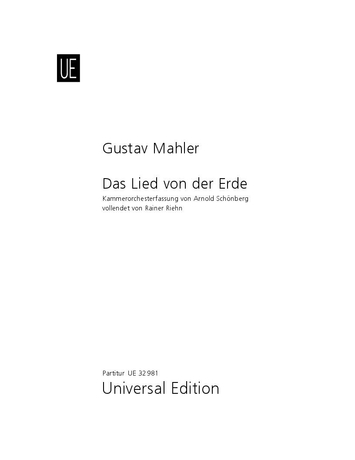.png)
Payments:
Shipping:
Gustav Mahler
Mahler: Das Lied der Erde (The Song of the Earth) for tenor and alto (baritone) soloists and orchestra, for tenor and alto (baritone) soloists and orchestra
Text bearbeitet von: Gustav Mahler
Bearbeitet von: Rainer Riehn Arnold Schönberg
Textvorlage: Hans Bethge
UE32981
Release info: vollendet von Rainer Riehn 1983
Type: Partitur
Languages: Deutsch
Format: 232 x 305 mm
ISBN: 9783702428051
Pages: 256
ISMN: 979-0-008-07632-9
Payments:
Shipping:
Audio preview
Description
According to Alma Mahler’s memoirs, ‘years ago’ an old friend of her family (Dr. Theobald Pollak) gave Mahler ‘the newly translated “Chinese Flute” (Hans Bethge). These poems pleased Mahler enormously, and he set them aside for later. […] now these immeasurably sad poems came back to him, and already in Schluderbach, during long, lonely walks, he sketched the orchestral songs that would become “The Song of the Earth” one year later!’ But Alma’s writings are frequently mistaken (sometimes intentionally so). Alfred Roller, Mahler’s chosen stage director at the Opera who visited him in Schluderbach, reports: ‘This summer remained without artistic fruit.’ Moreover, the Börsenblatt für den deutschen Buchhandel announced the publication of Bethge’s Die chinesische Flöte only on 5 October 1907, well after Mahler had left the Tyrol for Vienna. Even had he received an advance copy (which seems unlikely), Mahler’s later correspondence plus the dated manuscripts of his new work – as yet untitled – indicate that it was composed largely if not entirely during the summer of 1908. It seems curious that Mahler should have found texts so well suited to his purpose in poems from the 8th century T’ang dynasty. But these verses are not ‘newly translated’; rather, they are reworkings of earlier German and French translations, twice and thrice removed from the original Chinese. Appropriately, Bethge calls them ‘Nachdichtungen’ (paraphrase poems). Bethge was no Sinologist, but rather an ‘empathetic aesthete’ (Einfühlungsaesthetiker); in his view, ‘Translating a poem literally is not what matters; what matters much more is to enable the spirit, the style, the melody of a poem to arise somewhat anew in the foreign language.’ The result in many respects resembles German late 19th century poetry with added oriental overtones. From this collection of 83 paraphrases of 38 poets, Mahler ultimately selected seven and shaped them into an allegory of transitory existence merging into eternity. And as he had done with the Wunderhorn- and Rückert-Lieder, he retouched the poetry to serve his own expressive purposes (most notably, the rapturous concluding lines of Der Abschied are his own, beginning with ‘Still ist mein Herz, und harret seiner Stunde!’ [Still is my heart, and awaits its hour!]). Nevertheless, the oriental impetus is inherent in Das Lied von der Erde through its Yin-Yang polar dynamism of opposites – night / day, autumn / spring, youth / death, intoxication / meditation, and in the distribution of the singing, high/low (usually tenor / alto; see below). Additionally, the anhemitonic pentatonic scale, which is the most common mode of pitch organization in Asian music, is motivically prominent in every movement, and Mahler draws as well upon the improvisational practice of heterophony (the ‘indistinct unison’, as Adorno termed it).
In the summer of 1908 Mahler found it extremely difficult to resume composing, as two poignant letters to Bruno Walter attest. On 18 July he writes: ‘But, without here trying to explain or describe to you something for which there are perhaps no words at all, I shall only tell you that quite simply at a stroke I lost all the clarity and reassurance that I ever achieved; and that I stood vis-à-vis de rien [face to face with nothing] and now at the end of a life I must learn to walk and stand as a beginner. –’ In particular, his doctors’ restrictions against physical activity, including his customary vigorous walks, left him miserable: ‘I can’t work at a desk. For my inner activity I need outer activity. […] I confess – superficial though it seems – this is the greatest calamity that has ever befallen me. I must absolutely begin a new life – and in that I am also a complete beginner. –’ Yet he successfully accomplished this difficult transition. In early September, just over six weeks later, he could report to Walter: ‘I was very diligent (from which you can gather that I’ve fairly well “gotten used to things”). I myself do not know how to express what the whole thing might be called. A beautiful time was granted me, and I believe it is the most personal thing I have yet created.’
According to several contemporaries, Mahler’s reluctance to give this latest composition a title stemmed from a superstitious fear of a Ninth Symphony – the last of the genre for both Beethoven and Bruckner.
Finally during the winter of 1909–1910 Mahler entitled the work Das Lied von der Erde on the same sheet of paper where he assigned the much-feared number 9 to the symphony he had completed the previous summer.
Stephen E. Hefling
March 2010
Contents
Das Trinklied vom Jammer der Erde
Der Einsame im Herbst
Von der Jugend
Von der Schönheit
Der Trunkene im Frühling
Der Abschied
More information
Release info: vollendet von Rainer Riehn 1983
Type: Partitur
Languages: Deutsch
Format: 232 x 305 mm
ISBN: 9783702428051
Pages: 256
ISMN: 979-0-008-07632-9

